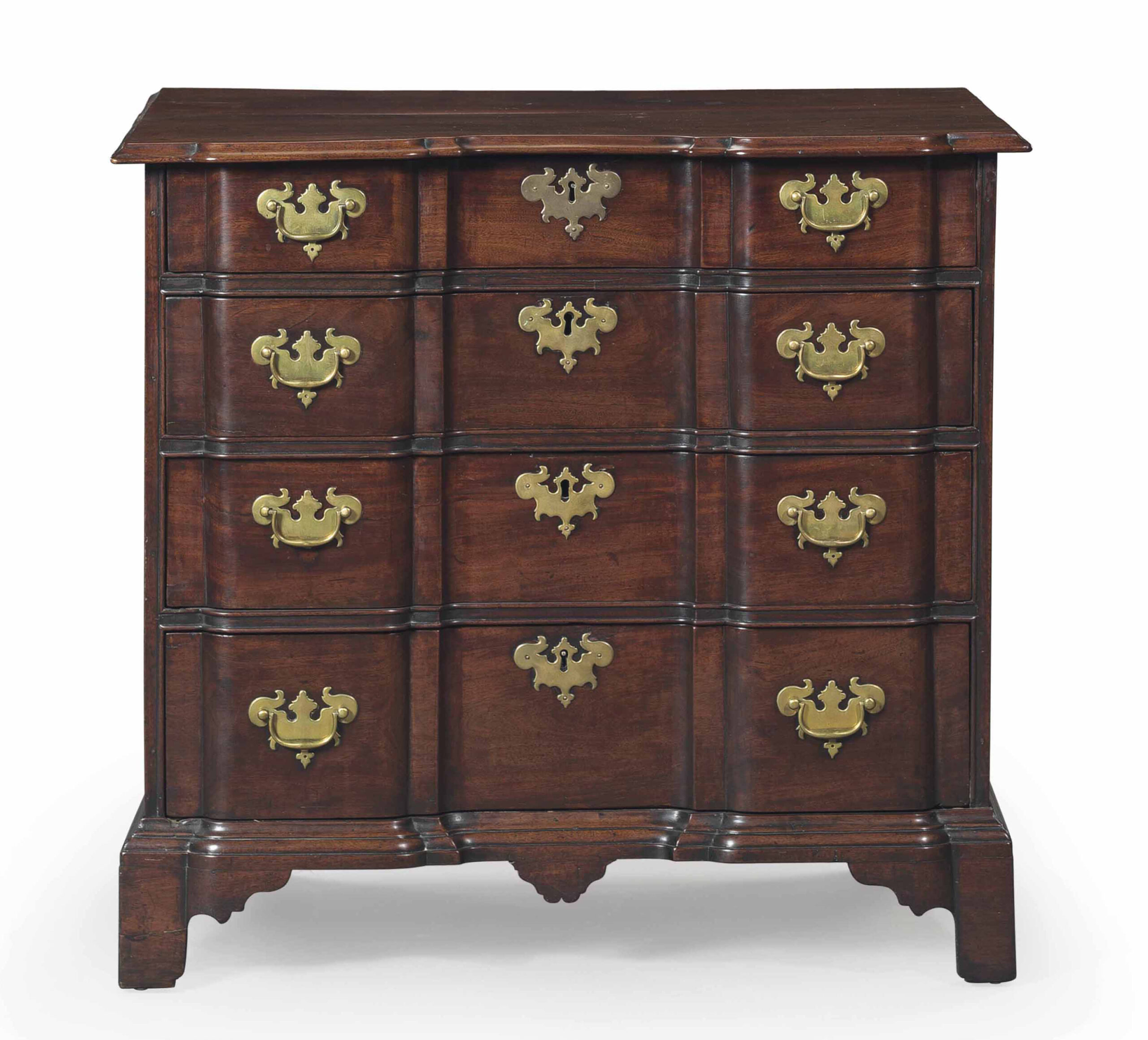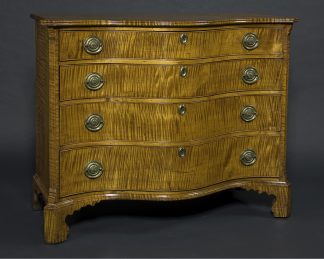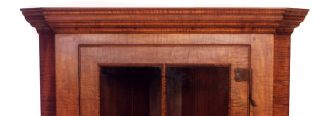Description
 The Boston Blockfront Chest is a distinctly American form. Not only are the drawer fronts stepped (or blocked) to form symmetrical concave and convex surfaces, but the top, base molding, and feet are blocked as well.
The Boston Blockfront Chest is a distinctly American form. Not only are the drawer fronts stepped (or blocked) to form symmetrical concave and convex surfaces, but the top, base molding, and feet are blocked as well.
Boston Blockfront Chest
This 5-day class begins with case construction. You’ll learn how to form the blocked drawer blades that separate the four blocked drawer fronts. With the case together, you’ll move on to forming the drawer fronts to match the blades. The week wraps up with the creation of the base molding and feet.
Some of the skills learned in the Pembroke Table class are:
- How to make blocked drawer fronts
- Make a beaded case
- Carve blocked bracket feet
Materials are not included in the class fee. Lumber for this project may be purchased through us or on your own and shipped to our shop at least four weeks prior to the class.
Each student should supply his, or her, own:
- Safety glasses and hearing protection
- Combination or machinist square
- Bevel gauge
- Bench chisels
- Carvers mallet
- Dovetail saw
- Marking gauge
- Smooth plane or jack plane
- Block plane
- Tape measure or folding rule
If you do not have the tools on the list, don’t panic, there are plenty of tools for your use in class.
Course Dates:
- January 4 – 8, 2021
Previous Dates:
- Aug. 10 – 14, 2020
The shop opens at 8:30 am. Class begins at 9:00 am. A delicious lunch, snacks, and soft drinks are provided. Class ends at 4:30 pm – the shop remains open until 5:30 pm.
The class is limited to a maximum of 3 students.
Call or email to be placed on the waiting list if this class sells out.





dcfeola (verified owner) –
There is one word that completely describes every aspect (the project, the instructor, the shop, the teaching, and the hidden extras) of this course — outstanding.
The project, a reproduction of a mid-late 18th century Boston Blockfront Chest, is an heirloom in itself. When you complete the project, its viewers will be in in awe of the accuracy, precision, and quality of its build. Starting with the beading on the drawer blades and case sides to the matched blocking of the drawers and the drawer blades, this piece represents New England Period Furniture at its finest.
As far as instructors go, Chuck Bender is one of the best. From his knowledge base of Period Furniture, to his skills and experience in furniture making using both power and hand tools, it’s hard to find an instructor that is more well-rounded and who is willing to share his trade with others.
Chuck teaches in an organized fashion starting with the design of the piece, proceeding then to wood selection, construction, assembly, and ends with how to finish and complete your work of art. He was always prepared for class, having all of his materials ready prior to the start of class. He was mobile about the shop in helping students individually as well as providing time where the students worked without his supervision.
Chuck Bender’s teaching methods were excellent and extremely easy to follow. He would demonstrate and explain each step along the way with a reason for why each step was to be completed at that time. The atmosphere of the class was relaxed but we were pushed to complete tasks within an appropriate amount of time. Chuck was always available to answer questions and redemonstrate any concepts that were confusing. He was also always willing to share tips and tricks to make our project easier and more valuable. Take, for example, gluing up two pieces of wood to make the case sides. Chuck took at least ten minutes to show how to grain and color match the two pieces of wood to produce a final case side that appeared to be made from one piece of wood. Chuck’s diligence and insistence to produce high quality, professional work was exhibited throughout the five-day class.
The shop, which was built within the past five years, contained some of the best power tools made. Being used to my six-inch jointer and thirteen-inch planer at home, I was a bit overwhelmed by his shop’s twenty-inch planer and his well oversized combination planer/jointer. His sliding table saw was something that I’ve never seen before. The air filtration system, which was attached to each power tool, automatically kicked on whenever a power tool was started. Needless to say, the shop was clean, and its tools were organized. (I took tons of photos to take home to steal Chuck’s system for tool organization for my shop.) Each student had his own bench and private work area large enough to work and not bother another classmate. If there was a tool that I didn’t have or forgot to bring, Chuck was always willing to loan me one of his.
One of the things that I appreciated most during the week was Chuck’s willingness to answer any off-topic questions during “break times”. If I had a question about finishing, he could have said, “Take my finishing class.” Instead, he took the time to completely answer my question, knowing that he could lose a future student in his finishing class.
Class hours were listed as 9:00 a.m. to 4:30 p.m. The shop was open well before the published time of 8:30 a.m. and on two days, we stayed and worked with Chuck’s help well after 6:00 p.m. Each day, class started promptly at 9:00 a.m.
Ahh — now, the surprise hidden extras. Unbeknownst to me, Chuck provided a hot lunch every day of the class. He also provided unlimited coffee, cold drinks, snacks and a homelike hospitality. He was cheerful and an inspiration for each student.
The price you pay for this class is well worth your investment. I know that I left class each night exhausted from working but I awoke the next morning with excitement not being able to wait for the start of the class. I came home with a piece that my family and friends will cherish for a long time.
David C. Feola
Retired School Principal and University Professor